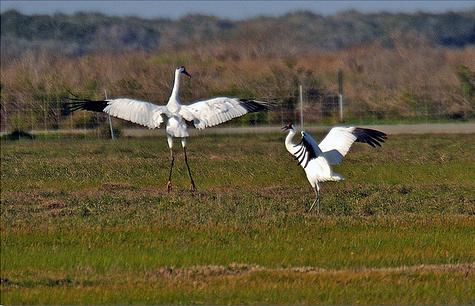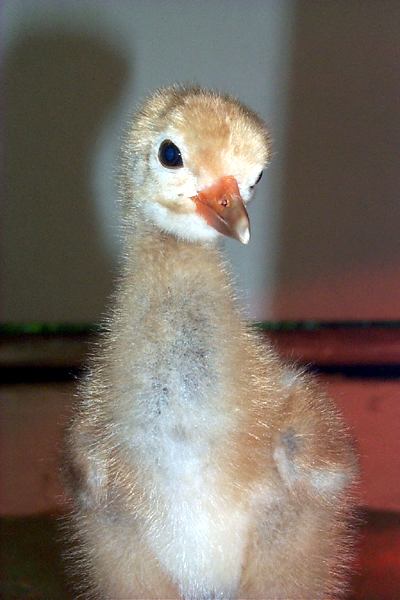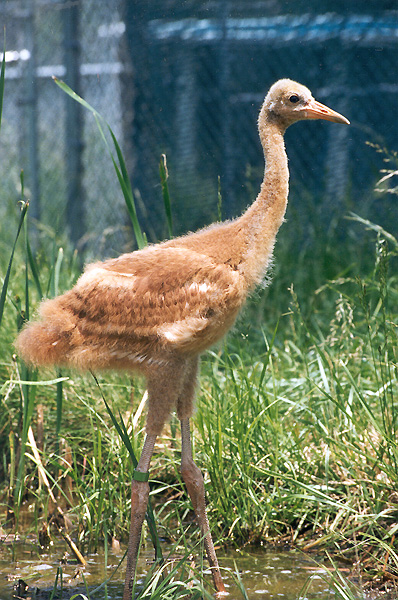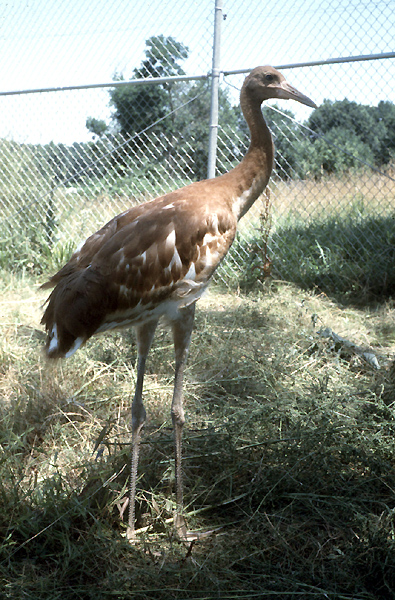
Where do baby whoopers come from?
![]() Did
you know that whooping cranes are mates for life? Once the
whooping cranes reach the age of mating, which is usually around
five years, they find a compatible mate and stay with them until
their partner dies, in which case they will find a new mate. The pair then chooses a nesting
territory,
which is usually about 5 square kilometers. In late April/early May, the cranes will use bulrush and cattail stems to
create a large nest (surrounded by water) in which the female will lay two eggs which
will then be incubated by both the male and female for 30 days.
Did
you know that whooping cranes are mates for life? Once the
whooping cranes reach the age of mating, which is usually around
five years, they find a compatible mate and stay with them until
their partner dies, in which case they will find a new mate. The pair then chooses a nesting
territory,
which is usually about 5 square kilometers. In late April/early May, the cranes will use bulrush and cattail stems to
create a large nest (surrounded by water) in which the female will lay two eggs which
will then be incubated by both the male and female for 30 days.
Before all of this happens, however, a sort of mating "dance" occurs between the pairs. This dance includes many "moves" which includes leaping into the air, flapping their wings, tossing their heads back, and flinging objects, such as grass and feathers, into the air. To see the whooping cranes in action, click here to watch a short clip of their dancing!
 The
average whooping crane egg is around four inches long and weighs
about seven ounces. The egg typically has tan and brown
splotches on it with the main egg color varying from soft blue,
to gray-green or tan. After the 30 day incubation period,
the baby whooping crane will emerge from the egg, being born
with blue eyes and cinnamon colored down feathers.
There isn't any way to tell what sex the chick is without a
blood test, which they do in conservation to keep track of the
numbers of males and females born, which is very important in
tracking these birds.
The
average whooping crane egg is around four inches long and weighs
about seven ounces. The egg typically has tan and brown
splotches on it with the main egg color varying from soft blue,
to gray-green or tan. After the 30 day incubation period,
the baby whooping crane will emerge from the egg, being born
with blue eyes and cinnamon colored down feathers.
There isn't any way to tell what sex the chick is without a
blood test, which they do in conservation to keep track of the
numbers of males and females born, which is very important in
tracking these birds.
Sadly, the first chick to hatch gains a definite advantage over its sibling with a few days living experience. This in turn causes the second chick to commonly being killed by the first chick due to competition for food. It is rare for a pair to raise both young. Don't lose hope though! The second egg is sometimes taken from the nest to be reared in captivity or by sandhill cranes, increasing the numbers of chicks being born each year.
The young whooping crane undergoes many changes while growing. When the chick approaches three months, their eyes will turn aquamarine. The yellow color that is seen on adult whooping cranes will appear when the chick reaches the age of six months. Feathers will be grown that are white and the same cinnamon color with black wing tips at around 40 days. Enjoy these pictures of cranes growing up below to see the changes!
After a year, the young whooping crane will exhibit the markings as seen on the adult, which can be described on my Appearance page. In the wild, whooping cranes may live up to 25 years, while in captivity they can reach to be over 40 years old.
If you skipped the section on the adult whooping crane appearance, visit my Appearance page by clicking here. If you want to learn even more about these creatures, I suggest moving onto my Interactions page here. However, if you'd like to start over or visit my homepage, click here.



